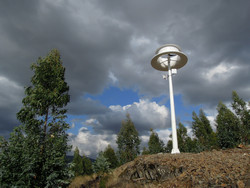Omniflow to expand its range of products combining solar and wind energy
If wind and solar energy can help decrease businesses’ and households’ carbon footprint while reducing energy costs, they also have significant shortcomings. First, solar energy can only be collected during the day, while wind turbines are much more efficient at night. Then, standard wind turbines’ unidirectional axis perform poorly in turbulent, changing urban wind conditions… In other words, these energy sources need backup from standard electricity grids or powerful battery technology to sustain a 24/7 electricity demand. This is where Omniflow comes into play. The patented technology, which recently received EU support under phase 1 of Horizon 2020’s SME instrument, solves all of these problems with a novel turbine design harnessing both wind and solar energy simultaneously. ‘Because we combine two sources of energy instead of just harnessing light or wind, we don’t need to resort to the big battery banks required by standard equipment. And the Omniflow batteries will last longer because they discharge less and have less cycles over time,’ explains Pedro Ruão, CEO of Omniflow. ‘Also the fact that wind usually blows stronger during the winter and that the sun shines longer in summertime makes these energy sources complementary, which is very convenient for the storage components. This way we can have more stable and reliable systems, with batteries lasting 16 years or even longer.’ Trapping the wind wherever it comes from Some could say Omniflow is a UFO by today’s renewable energy production standards, which coincidentally is precisely what it looks like: the modular, wing-shaped airfoils combine in a circular device which sits on a mast of variable size depending on the application. At its centre swirls a vertical axis turbine capturing and accelerating the wind from any direction, while the air passing above the turbine combines with the air stream coming from the turbine in a cyclonic updraft vortex flow. Icing on the cake, the surface of the device is covered by photovoltaic cells. Altogether, Omniflow promises an energy bill reduction, higher energy production than with standard turbines, low noise emissions, no nuisance for birds, no vibration transition to the mast and ground, and three solar zones with independent Maximum Power Point Tracking (MPPT) for a reduced impact of shading. The company targets households and commercial buildings alike, and advises potential customers on the best solution based on their location. ‘The average daily production really depends mostly on site conditions like the average annual wind speed, but a good site can have a return on investment within five to eight years, a major part of this return depending on the local cost of energy,’ Ruão notes. ‘That’s why we always need to analyze local conditions and after that we can decide what system to use.’ Unlimited applications The company proposes three models for energy production and another one for Smart Street Lighting (Omnilight). Identifying high potential markets for these solutions and other future offerings was at the heart of the feasibility study funded under the Horizon 2020 OMNIFLOW project, from which Ruão and his team learned a lot. ‘Our feasibility study shows that the intended development of a rugged line of Omniflow products for harsh environments – extreme cold and windy locations, maritime environments (sea buoys) and hot desert – will surely be a source of success. It will create new markets for the application of Omniflow technology and contribute to possible technical improvements to our regular line of products.’ One of the focuses of the company for the next few months will be the drafting of its phase 2 application, so that the Omniflow systems can be tested in the harsh environments mentioned. The new systems could, notably, be used to power surveillance and monitoring systems, mobile telecommunication towers, military and humanitarian base stations or sea buoys, but also to provide off-grid street lighting – the company’s most recently-discovered application that has already grown to become its most important one. Ruão concludes: ‘We are already working with large multinationals on this line of products, for which the market is becoming very sensitive. If our phase 2 application gets the expected approval in early 2016, we expect to commercialise Omniflow NEXT and our rugged line of products in 2018.’ For further information, please visit: Omniflow http://omniflow.pt/
Countries
Portugal



